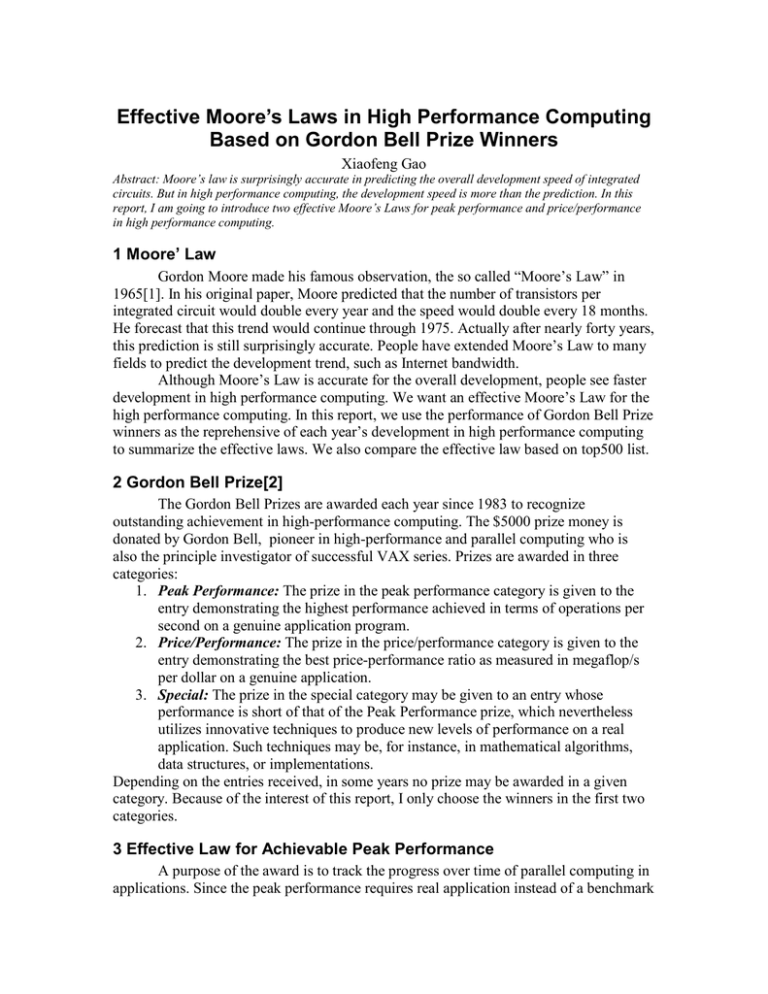Effective Moore`s Laws in High Performance Computing Based on
advertisement

Effective Moore’s Laws in High Performance Computing Based on Gordon Bell Prize Winners Xiaofeng Gao Abstract: Moore’s law is surprisingly accurate in predicting the overall development speed of integrated circuits. But in high performance computing, the development speed is more than the prediction. In this report, I am going to introduce two effective Moore’s Laws for peak performance and price/performance in high performance computing. 1 Moore’ Law Gordon Moore made his famous observation, the so called “Moore’s Law” in 1965[1]. In his original paper, Moore predicted that the number of transistors per integrated circuit would double every year and the speed would double every 18 months. He forecast that this trend would continue through 1975. Actually after nearly forty years, this prediction is still surprisingly accurate. People have extended Moore’s Law to many fields to predict the development trend, such as Internet bandwidth. Although Moore’s Law is accurate for the overall development, people see faster development in high performance computing. We want an effective Moore’s Law for the high performance computing. In this report, we use the performance of Gordon Bell Prize winners as the reprehensive of each year’s development in high performance computing to summarize the effective laws. We also compare the effective law based on top500 list. 2 Gordon Bell Prize[2] The Gordon Bell Prizes are awarded each year since 1983 to recognize outstanding achievement in high-performance computing. The $5000 prize money is donated by Gordon Bell, pioneer in high-performance and parallel computing who is also the principle investigator of successful VAX series. Prizes are awarded in three categories: 1. Peak Performance: The prize in the peak performance category is given to the entry demonstrating the highest performance achieved in terms of operations per second on a genuine application program. 2. Price/Performance: The prize in the price/performance category is given to the entry demonstrating the best price-performance ratio as measured in megaflop/s per dollar on a genuine application. 3. Special: The prize in the special category may be given to an entry whose performance is short of that of the Peak Performance prize, which nevertheless utilizes innovative techniques to produce new levels of performance on a real application. Such techniques may be, for instance, in mathematical algorithms, data structures, or implementations. Depending on the entries received, in some years no prize may be awarded in a given category. Because of the interest of this report, I only choose the winners in the first two categories. 3 Effective Law for Achievable Peak Performance A purpose of the award is to track the progress over time of parallel computing in applications. Since the peak performance requires real application instead of a benchmark of some kernels, it would a more reasonable criteria to pick the most powerful machine of each year. So we choose Gordon Bell Prize as the representitive of development in high performance computing. Figure 1 shows the peak performance reported as the winning performance each year. Based on these data, we summarize the first effective Moore’s Law as : The achievable processing power of high performance computers increases 1.6 times every year or the processing power doubles every 15 months. On the other hand, the top 500 list1 uses LINPACK to rank the machines . We might wonder how good these two standards be consistent over the years. From Table 1 in Appendix A, we can see it is not always true that peak performance achieved on the most powerful machine in top500 list. ASCI White has been No.1 in top500 list for two years. It seems there is still no real application can achieve one-third of its Linpack score(7226GFlops). 8000 GFlops 7000 Top500 6000 5000 4000 N=1.9X 3000 N=1.6X 2000 1000 Bell 0 1993 1994 1995 1996 1997 1998 1999 2000 2001 Figure 1 Comparison of Peak Performance between Bell Prize Winners and Top Machine in Top500 List Figure1 shows the Rmax of the top machine in Top500 list increases by 1.9 times over the previous year. With this speed, the gap between these two peaks will increase in the future, which can be explained by the fact that the most powerful machines consists 1 There are two lists each year, here we only use the November’s lists thousands processors and it is difficult to a real application to use them efficiently. I also doubt the Bell Prize winner will kept this speed in the future on general purpose computers. Since people rely on increasing the number of processors to achieve better peroformance and the interconnection becomes more and more critical, it will be more difficult to efficiently use those MPP machines. 3. Effective Law for Price/Performance It’s very interesting that Gordon Bell prize includes a category for the best price/performance achieved in a year. From Figure 2, one can see how significantly the price for one 1MFlops drops. If we just compare the absolute number, the price for 1MFlops dropped from $2000 in 1989 to 92 cents in 2000. 2000 $ 1800 1600 1400 N=1/1.5 1200 1000 800 600 400 200 N=1/2.5 0 1989 1990 1991 1992 1993 1994 1995 1996 1997 1998 1999 2000 2001 Figure 2 Price for one MFlops Based on these data, we can come up with a law to summarize the trend of price/performance: The price for processing power drops 2.5 times every year or the price for processing power halves every 10 months I believe this speed should continue, or be more significant because of price for powerful commodity processors drops quickly and users will pay less for software because of open source software. Appendix A gives the list of winners in Best price/performance category. 4. Conclusion In this report, we summarize two effective Moore’s laws to predict the achievable peak performance and price for high performance computers: The achievable performance doubles every 15 months and the price halves every 10 months. I believe the trend for price will continue in the future, while the achievable performance may not keep up with this speed, especially on general purpose supercomputers. Reference: [1] Cramming More Components onto Integrated Circuits, Gordon Moore, Electronics April 1965 [2] http://www.sc2000.org/bell/ [3] top500 list archive http://www.top500.org/Main/Archive.php3 [4] SC2001 Proceedings [5] Multi-teraflops Spin Dynamics Studies of the Magnetic Structure of FeMn/Co Interfaces, A. Canning, B.Ujfalussy. et.al 2001 Supercomputing Proceedings. Appendix A: Winners of Peak Performance Year Machine 1988 Cray-YMP 1989 1990* 1992 1993 1994 CM-2 CM-2 Intel TouchStone Delta CM-5/1024PE Intel Paragon/1904PE 1995 1996* 1997 1998 Fujistu Numerical Wind Tunnel/128PE Numerical Wind Tunnel/166PE Grape-4/1269PE ASCI Red/4096PE Cray T3E/1024PE 1999 Blue Pacific 2000** Grape-6 20012 IBM 16way SP/3328PE 1996 Application Static Finite Element Analysis Seismic Data Processing Seismic Data Processing Simulation of nBody Modeling a Shock Front Structural Mechanics Modeling Quantum Chromo dynamics Simulation Fluid Dynamics Simulation of nBody Simulation of nBody Non-collinear magnetic arrangements Simulation of Fluid Turbulence Simulation of Molecular Dynamics Simulation of magnetic structure Performance 1GFlops Position in Top500 N/A 6GFlops 14GFlops 5GFlops 60GFlops 140GFlops N/A N/A N/A 1 1 179GFlops 1 111GFlops 2 333GFlops 430GFlops 657GFlops 1 2 1.18TFlops peak 1.04TFlops sustained 1.34TFlops 2 2.64TFlops 3 N/A * Honorable mention, not Bell Prize winner **Tie with another special purpose machine. 2 I don’t have the official 2001 Peak Performance winner. I was told by Allan Snavely that NERSC won this year’s Bell Prize. The data is based on NERSC’s paper[5] Appendix B: Winners of Best Price/Performance 1989 500MF for 1M$ on CM-2 1990 800MF for 1M$ on Intel iPSC/860 1992 1GF for 1M$ on a distributed heterogeneous machines 1993 6.5GF for 1M$ on a custom-built machine called SNAP 1994 3GF for 1M$ on a cluster of eight HP workstations 1995 3.6GF for 1M$ on 20HP workstations 1996 6.4GF for 1M$ on an SGI power challenge with 6 MIPSR8000 processors 1997 10.8GF for 1M$ on 28 DEC Alpha machines 18GF for 1M$ on cluster of 16 PentiumPro 200MHz 1998 79.7G for 1M$ custom system with 2048PE TI chips(32bit Fops) 64.9GF for 1M$ on 70PE DEC 1999 144GF for 1M$ on custom built Grape 5 32 processor 2000 92Cents/MFlops on a custom built PIII cluster


